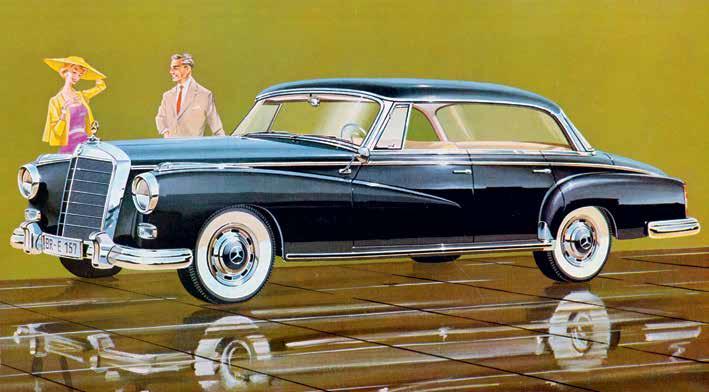
2 minute read
A glimpse into Mercedes-Benz marketing of yesteryear.

The Mercedes-Benz W186 model 300, the Maybach of its day and rival to the Rolls Royce Silver Cloud, was the largest, most prestigious and expensive car for the company when produced.
Advertisement
Built in several models from 1951 to 1962, the four-door luxury tourer was launched at the first Frankfurt International Motor Show and showcased futuristic technology such as a glass partition, VHF mobile telephone, and dictation machine.
Due to its size and status it soon became the favourite for representative purposes in politics and business with Chancellor Konrad Adenauer, President Theodor Heuss, Finance minister Ludwig Erhard and Social Democratic Party leader Kurt Schumacher among the first dignitaries to be chauffeured in the 300.
Technically, as well as conceptually, its roots go back to the 260 model of 1940, which did not go into mass production due to the war.
Its first version delivered 115 hp and reached a maximum speed of 160 kph. The framework and chassis basically followed the concept of the 170 S and 220 models but were adjusted to the higher weight and remarkable driving performance of the 300.
The most important technological advancement was an electrically activated torsion-bar suspension. Under extreme loads (the upper limit was 365 kg at first) it acted as a levelling device for the rear wheels.
Apart from the saloon, which was available with optional sun-roof, there also was a five or six seat Convertible D available in December 1958 which could be fitted with a sliding roof and/or an partition wall. The substantial price difference of DM 8,500 ensured exclusivity and a low number of units produced (around AUD$450,00 today).
Even more exclusive were four individual cars built in 1960 on the basis of the 300 D. Three of them, Pullman limousine and two Pullman landaulets were built on an elongated chassis with a 3600 mm wheelbase and with a higher roof. One of the two landaulets were fitted with a single armchair in the rear as an extra feature for Pope John XXIII. The second landaulet and the Pullman limousine remained in the factory as representation cars to be rented out to the government or wealthy clients for special events.
The fourth car, a completely new bodied two-door estate wagon, unfit for representation purposes and kept from the public, was used as a powerful measuring car in the test department for many years.










